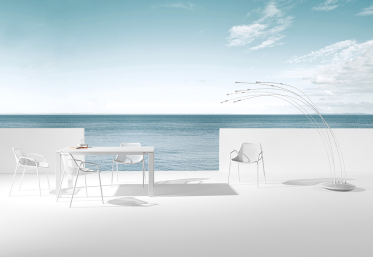
Amado House in Essendon by MAKE Architecture, winner of the Residential Exterior award at the 2017 Intergrain Timber Vision Awards. Photograph by Peter Bennetts.
With the summer and holiday season ahead of us our attention turns outdoors where, with a little care and the right decisions made early on, our decks and furniture can be just as we left them a few months ago.
Choosing the right timber and fixtures for a deck or outdoor space is essential and can save massive headaches in the long run. This is especially important if your deck is exposed to extreme shifts in temperature, direct sunlight or rain, and even more important for those in coastal areas.
While treated pine can last up 20 years if cared for properly, and is both termite- and rot-resistant, it is less durable than hardwoods such as Merbau that are less prone to marking and movement. The appeal of treated pine is that it is cheaper and generally is painted, whereas the beauty in more expensive hardwoods is the natural appearance of the timber itself.
When it comes to screws, nails and decking wire, similar attention should be given – with high-grade stainless steel being the most resistant to corrosion, though it too needs maintenance. Even away from the ocean, a pool-side deck is exposed to chlorine and the last thing you want to spend your winter doing is rewiring your deck or pulling out rusted nails.

Caring for metal, timber and furniture is crucial for longevity. Featured here the ARENA by RODA, available through DOMO.
The same applies to outdoor furniture where tea staining can be a common problem in stainless steel elements. This yellowing of the metal can be cleaned off, but will reoccur and the best prevention is to begin with a high-quality polished surface such as found in 316 Marine Grade stainless. Electropolishing or powder-coating are also effective alternatives, though the general rule of thumb is: the smoother the surface, the fewer pollutants and corrosive elements can stick to the surface.
For extreme conditions a sacrificial anode is an option. Commonly found at boating or camping stores, this is a small piece of zinc used to reduce corrosion on aluminium boats. Being far more corrosive than most metals, it is a simple piece of science that can save you massively for very little cost.
Having explored the hard stuff, outdoor upholstery is another important consideration, with textiles and foams being created specifically for this purpose. These materials are designed to withstand the elements and in Australia those elements can be extremely harsh on fabrics and cushions.

Adam Goodrum’s Trace outdoor collection for Tait features upholstery that allows water the move through the foam, rather than sit on top. Photograph Haydn Cattach.
There are two approaches when it comes to exposure to rain and moisture. One is to repel liquid at the surface by using synthetic textiles, and the other is using foams specifically created to encourage the water to drain through. The advantage of the latter is twofold: first, the fabrics used in this type of upholstery can be porous and thus carry more of a feeling we are used to in our indoor furniture and, second, a far more lounge-like level of comfort can be achieved – similar to what you may be used to in an indoor lounge, and without the embarrassment of your guests sitting down to a wet sponge.
Regardless of your material choices, of course, everything outdoors needs proper maintenance and care to ensure your initial outlay holds its value for years to come.
For a comprehensive overview of decking timbers and their properties this is a good start:
http://www.brittontimbers.com.au/decking
To find out more about timber finishes and see more projects that use timber: http://www.intergrain.com.au
WRITTEN BY HouseLab






